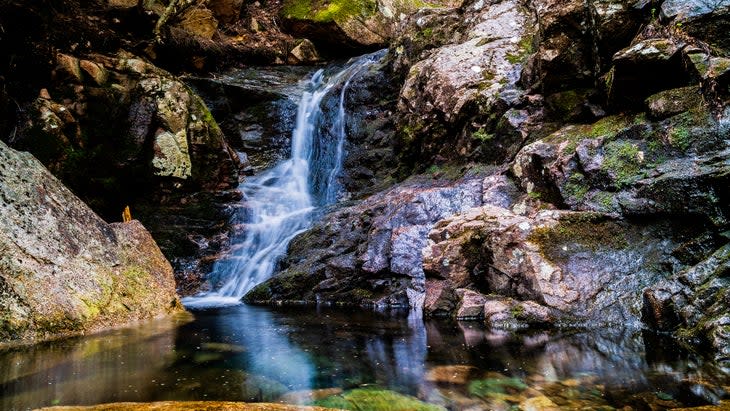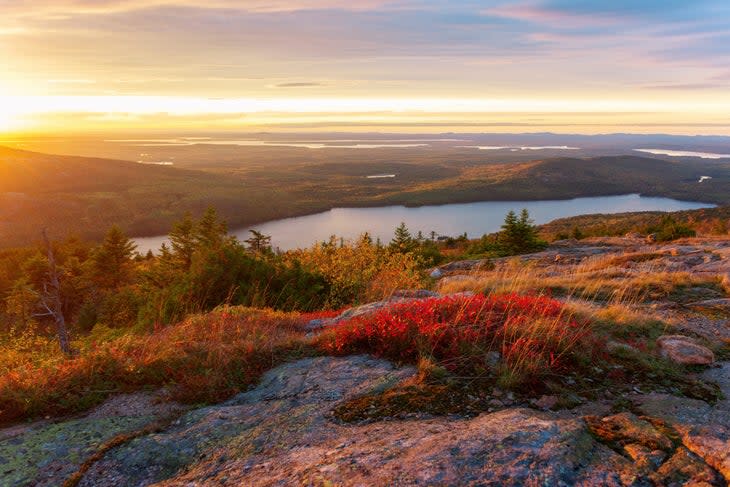How to Hike Acadia National Park’s Cadillac Mountain
This article originally appeared on Backpacker
If Acadia is the king of the New England coast, then Cadillac Mountain is its crown. The highest peak on the Atlantic coast from New England to Florida at 1,530 feet, its summit rewards hikers with panoramic views of the park’s forested hills, mountains, and scattered islands, with the ocean stretching endlessly beyond. Head up one of the ridge trails before dawn to catch one of the best sunrises anywhere, or turn it into an all-day excursion with a loop over to Dorr Mountain or the Gorge Trail.
North Ridge Trail

Length: 4.6 miles
Elevation Gain: 1,171 feet
Difficulty: moderate
trail type: out-and-back
This moderate climb heads through evergreen forest to the peak. Start on the Kebo Brook Trail, then turn up a set of stone stairs to meet up with the North Ridge Trail. About a mile in, enter the woods; the trail gets rockier here, so make sure to wear a sturdy pair of hiking boots or trail runners. Exit the trees and climb a granite-dotted slope, following cairns, to the top of Cadillac Mountain and the promised views of Acadia’s coastline and the Atlantic Ocean.
Gorge Trail

Length: 3.5 miles
Elevation Gain: 1,241 feet
Difficulty: moderate
Trail type: out-and-back
This shady route up the chasm between Cadillac and Dorr Mountains is a great choice for sunny summer days, when you’d rather escape the heat. Start at the Gorge Trail trailhead, then cross a stream and a boardwalk before starting the climb. With impressive granite cliffs to either side-plus scattered waterfalls-this path is just as dramatic as the north and south ridges, without the same crowds. Turn right at the intersection near the top to head up to Cadillac Mountain’s summit.
South Ridge Trail

Length: 6.3 miles
Elevation Gain: 1,370 feet
Difficulty: moderate
trail type: out-and-back
Earn your lobster on the South Ridge Trail, which climbs sharply to Cadillac's broad ridge crest. There, nonstop views of Acadia's peaks, the surrounding ocean, and a constellation of islands accompany you all the way to the park's highest summit. The hike is 7 miles out and back from the trailhead on ME 3, near Blackwoods Campground. Start well before dawn and you'll beat the crowds and catch a spectacular summit sunrise.-Mike Lanza
Dorr Mountain Loop

Length: 8.8 miles
Elevation Gain: 3,298 feet
Difficulty: difficult
Trail type: loop
From the Sieur de Monts Spring Nature Center, head southwest on the trail that switchbacks up the lower slopes of Dorr Mountain past intermittent views of the Porcupine Islands and Frenchman Bay. Midway up the mountain, the trail traverses south before cresting Dorr's summit, dropping down a gully on the west face, and then climbing up the east ridge of 1,530-foot Cadillac Mountain--Acadia's highest peak. At the top, expansive views of the Atlantic stretch out to the south, and options for lengthening or shortening this trip are available. This loop descends to Bubble Pond before climbing back up to the broad, 1,248-foot summit of Pemetic Mountain. After descending this third peak, the trail climbs to the top of one more ridge before descending along Canon Brook and heading north past The Tarn Lake back to the Nature Center.-mapped by Trung Q Le
Gorge Trail Loop

Length: 4.4 miles
Elevation Gain: 1,463 feet
Difficulty: moderate
Trail type: loop
This 4.4-mile loop makes for a good half-day excursion, with excellent views. Starting from the North Ridge Trailhead, follow the blue blazes upward, taking in views of Bar Harbor and the islands beyond along the way. Climb a set of stone steps paralleling the park road before reaching the summit, where the views expand to a full 360-degree panorama of Acadia’s forests, mountains and islands. Drop onto the Gorge Trail, descending through ancient granite and talus. Pass a waterfall before reaching the Gorge Trail trailhead, then head .6 miles up the road to your car.
Keeping Cadillac Mountain Green: Summit Restoration Projects
The top of Cadillac Mountain is home to a unique set of subalpine plants-145 different species of them. Ranging from lichens and mountain firmoss to gray birch, they cling to the exposed granite, weathering storms, wind, and fog. The thousands of visitors that hike the peak, though, have taken their toll. In order to restore the areas scraped bare of soil and root systems by countless feet, the park service has begun restoration projects on Cadillac. Using local loam and seedlings from nearby communities made up of similar plants, the summit is being restored to its former glory.
When to Hike Cadillac Mountain
It's hard to really soak in Cadillac's ocean views in the middle of a thunderstorm, so checking the forecast is essential. Summer is the most popular time to hike Cadillac Mountain, when the weather is warm and the most sunny days occur. In fall, though, the undergrowth on the way to and at the summit turns to brilliant red, yellow, and gold, as do the surrounding forests visible from the peak. In spring and winter snow can make for a slick climb, but it also keeps the crowds away, so with the proper gear that can be a great time to hike Cadillac, too.
For exclusive access to all of our fitness, gear, adventure, and travel stories, plus discounts on trips, events, and gear, sign up for Outside+ today.